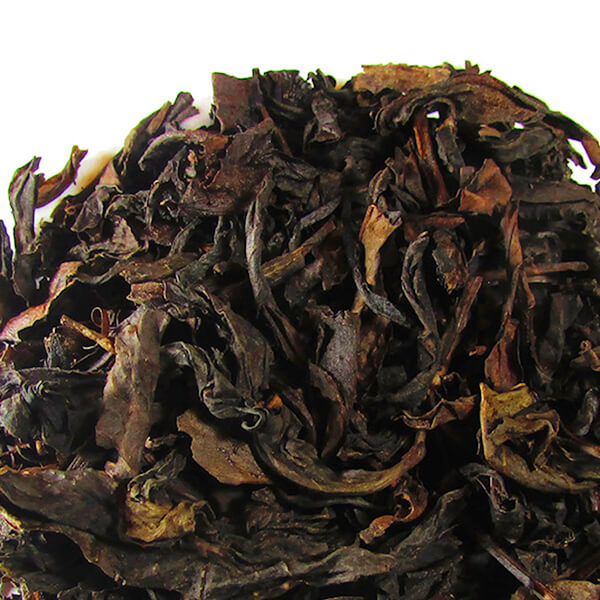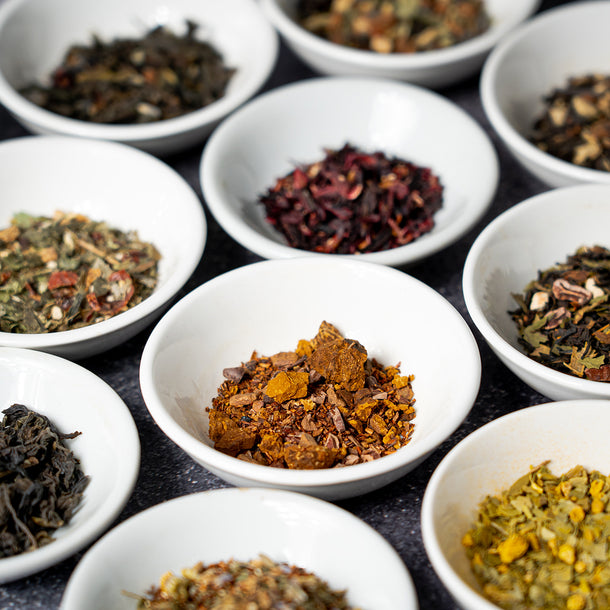In a very general definition, loose leaf tea is a tea that does not come prepackaged in tea bags.
Unlike bagged tea, loose leaf tea isn’t crushed into a teabag, allowing it to keep its flavor, aroma, and health benefits.
How do you steep loose leaf tea then? You can steep loose leaf tea with a steeping ball, infuser, french press, or strainer! What’s cool about this method is there’s much less waste than with bagged tea.
Loose Leaf Tea vs. Bagged Tea
Loose leaf tea is significantly different in both flavor and quality compared to bagged teas. In addition to the quality of the tea, loose leaf tea is more environmentally friendly as well, since you can compost loose leaf tea easier, and teabags aren't required.
Keep in mind that there are different grades of bagged tea. These grades include dust, fanning, and broken leaf.
Dust & Fanning
The teabags you buy at the grocery store contain dust and fanning grades of tea. Brands that sell this tea must crush the leaves when packaging into tea bags.
Broken & Loose Leaf
Being higher quality than dust and fanning, broken leaf is still "broken" in order to fit into a more spacious tea bag. Broken leaf tea still suffers from excess waste.
Loose Leaf Tea
Loose leaf tea, also known as whole leaf tea, comes in “bulk” form, such as a bag or tin. Loose leaf tea is better for you, the environment, and your wallet! Plus, it’s tastier!

What Are The Benefits Of Loose Leaf Tea?
All teas provide some level of antioxidants, vitamins, nutrients and have anti-bacterial properties. In our “types of tea” snippet below, you can learn more about each type of tea and its health benefits!
- Black Tea: Great for digestion, heart health, energy, and immunity.
- Green Tea: Memory, dental health, cancer prevention, metabolism.
- Herbal Tea: Sleep, immune system, inflammation (varies with herbs).
- White Tea: Cholesterol, reproductive health, weight loss, brain health.
- Pu-Erh: Blood pressure, stress relief, weight loss, digestion.
- Oolong Tea: Diabetes, inflammation, weight loss, brain health.
How Much Loose Leaf Tea Per Cup?
Receiving a bag of loose leaf tea for the first time can be a little overwhelming. Fortunately, steeping instructions remain consistent across most brands.
You can find out how to steep your loose leaf tea via the instructions on your packaging. You’ll need 1 - 2 teaspoons for every 8 ounces of tea. Loose leaf tea can be re-steeped up to 3 times!
How To Make Loose Leaf Tea
When you receive loose leaf tea for the first time, the thought of steeping the tea can be overwhelming. Think of loose leaf tea as tea without the teabag! It’s virtually the same, with more ways to steep depending on your taste and preference.
Steeping with a french press is easy and great for steeping more than one cup of tea.
- Depending on how much tea you plan to serve, bring your measured water to a boil.
- Place 1 tablespoon of loose leaf tea per 8 ounces into the bottom of your french press.
- Place your french press lid into position and allow the tea to steep for the appropriate amount of time (indicated on your label).
- Slowly push the french press plunger down, this separates the water from the tea.
Infusers exist to replace tea bags but maintain the quality and taste of loose leaf tea. Even better, they’re reusable and easy to use!
- Boil 8 ounces of water.
- Place 1 tablespoon of loose leaf tea into your infuser. If you don’t already have one, feel free to shop our selection of infusers!
- Place your infuser inside of your cup, and carefully pour the hot water over the infuser filling up your mug.
- Let the tea steep for the desired amount of time. If you’re unsure how long you need to steep for, our packaging comes with recommended times!
Loose leaf tea is best brewed with a teapot designed to brew loose leaf tea. These teapots have built-in infusers or tea strainers, which you can remove to avoid over steeping. Teapots come in different sizes, so you’ll need to follow the one tablespoon per 8 ounces.
- Depending on how much tea you plan to serve, bring your measured water to a boil.
- Place 1 tablespoon of loose leaf tea per 8 ounces into the strainer inside of your teapot.
- Once your teapot comes to a boil, remove the strainer.
If you're new to loose leaf tea, we recommend trying with teabags first! If you find you enjoy loose leaf tea, you're welcome to shop one of our infusers.
- Boil 8 ounces of water.
- Place 1 tablespoon of loose leaf tea into your teabag.
- Place your teabag inside of your cup, and carefully pour the hot water over the teabag filling up your mug.
- Let the tea steep for the desired amount of time. If you’re unsure how long you need to steep for, our packaging comes with recommended times!
Where Can I Buy Loose Leaf Tea?
Shameless plug, but we blend and ship our loose leaf tea in Southern Oregon! We’re very proud of our teas. In fact, with over 10,000 positive reviews, we’re the spot for tea! You can check out our full catalog of loose leaf teas here.
If you’re more of an in-store shopper – you’ll be able to find loose leaf tea at any natural grocery store such as Whole Foods.
How Do I Choose Which Tea To Drink?
Choosing which teas to drink can be challenging. There’s a multitude of flavors, health benefits, and whether the tea is caffeinated or not.
Below we’ve outlined several teas, their health benefits, and flavors to help you decide. Want to sample something? We love to gift samplers to every order; if you have a specific request, leave a message in your order notes!
Types of Loose Tea
Black Tea
Perhaps the most common tea, black tea, is made from highly oxidized Camellia Sinensis, a plant common in most teas. This oxidization gives the tea leaves their dark color. Standard blends of black tea include English Breakfast, Earl Grey, and Chai. Black tea is also a popular choice for making iced tea.
Black tea has a strong flavor and is packed with caffeine.

Green Tea
Along with black tea, green tea also comes from the Camellia Sinesis plant. Unlike black tea, green tea is minimally oxidized. Minimal oxidization is why the leaves are green in color. Green tea has a lighter, more vegetal taste.
Green tea is known for being a high source of antioxidants and for its many health benefits. Some traditional green teas include floral tasting Jasmine Tea and smoky-tasting Houjicha Matcha is a green tea powder.

White Tea
White tea is the least processed out of all the other teas. White tea is made from the same plant as black and green tea, but the tea leaves are exposed to heat as quickly as possible to stop oxidation, this gives the tea a mild and delicate flavor.
White tea is known for many health benefits, including helping lower blood pressure. Lower blood pressure makes white tea a popular choice for heart health. White tea is featured in our Organic Healthy Heart Tea.

Herbal Tea
Herbal tea is a blend of herbs and spices. Any tea that does not contain tea leaves from the Camellia Sinensis plant is considered an herbal tea. Almost all herbal teas are caffeine-free (one exception is Yerba Mate).
Because of the abundance of herbs, a large variety of flavors can be achieved in herbal blends. Some common herbal teas are Chamomile, Peppermint, and Rooibos.

Oolong Tea
Oolong tea falls somewhere in the middle of black tea and green tea. Oolong is oxidized more than green tea, but less than black tea. The tea is rolled into unique shapes, which can result in a variety of different flavors.
Dark oolong is more oxidized and has a bold nutty flavor. Green oolong is lighter in character and is exceptionally smooth.

Pu-Erh Tea
Pu-erh tea comes from the leaves of the Camellia Sinensis plant. Still, it goes through a unique process of oxidation and fermentation. Pu-erh is aged to get a unique flavor that no other tea has.
Pu-erh has a robust earthy flavor that lends itself well to chai and cocoa blends. Pu-erh is commonly used as a substitute for coffee because of its high caffeine content.

What Is The Shelf Life of Loose Leaf Tea?
Loose leaf tea has a remarkable shelf life! Because of general government mandates on food, Full Leaf Tea Co. prints a 2-year expiration date on loose tea and 1-year expiration date on Matcha.















